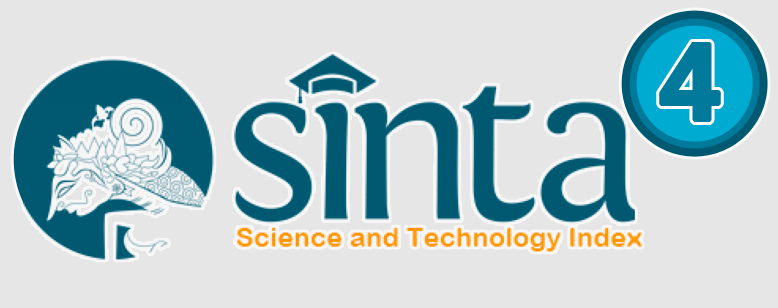RESISTENSI INSULIN DAN DISFUNGSI SEKRESI INSULIN SEBAGAI FAKTOR PENYEBAB DIABETES MELITUS TIPE 2
Abstract
Latar belakang : Diabetes melitus tipe 2 merupakan jenis penyakit DM yang terbanyak, penyebabnya faktor resistensi insulin dan disfungsi sekresi insulin. Resistensi insulin dan disfungsi sekresi insulin mengakibatkan Hiperglikemia yang berujung pada DM tipe 2. Hiperglikemia mengakibatkan gangguan mikrovaskuler pada retina, glomerulus ginjal dan saraf perifer, bahkan gangguan pada makrovaskuler seperti aterosklerosis, penyakit arteri koronaria dan stroke. Pengelompokkan resistensi insulin dan disfungsi sekresi insulin harus melalui pemeriksaan genotip, hal ini memerlukan biaya dan fasilitas yang memadai. Peneliti mengkaji berdasarkan terapi yang diberikan untuk mengklasifikasikan resistensi insulin atau disfungsi sekresi insulin. Tujuan : Mengkaji Resistensi Insulin dan Disfungsi sekresi insulin sebagai faktor penyebab DM tipe 2 di Kota Ternate. Metode : Tehnik purposive sampling sesuai dengan kriteria penelitian yang berjumlah 78 orang. Hasil penelitian diperoleh dan dianalisis dengan uji frekuensi untuk membandingkan subjek resistensi insulin dan disfungsi sekresi insulin. Hasil : Usia 50-60 tahun presentasi terbesar (50%), lama sakit 1-6 tahun dengan presentasi 76,9%, jenis terapi yang diberikan antidiabetik golongan Sulfonilurea (Glimepiride) dan Biguanid (Metformin) memiliki presentasi yang tertinggi (60,3%). Kesimpulan : Resistensi Insulin dan Disfungsi sekresi insulin sebagai faktor penyebab DM tipe 2 di Kota Ternate.
Â
References
American Diabetes Association, 2014, Standards of Medical Care In Diabetes-2014, Diabetes Care, Vol 37 Suppl 1
American Diabetes Association, 2015, Standar of Medical Care in Diabetes-2015, Diabetes Care, Vol 38 Suppl 1
American Diabetes Association, 2016, Standar of Medical Care in Diabetes-2016:Abridge for Primary Care Providers, Diabetes Care, 39 Suppl 1, S1-S12
Ashcroft FM, 2005, ATP-sensitive potassium channelopathies: focus on insulin secretion, JCI, 115 : 2047-58.
Badan Pengawasan Obat dan Makanan RI, 2010, Info POM, Vol 11 No 5, Jakarta
Dahlan MS, 2013, Besar Sampel dan Cara Pengambilan Sampel dalam Penelitian Kedokteran dan Kesehatan, Salemba Medika, Jakarta.
Direktorat Jenderal Bina Kefarmasian dan Alat Kesehatan Departemen Kesehatan RI, 2005, Phamaceutical Care untuk Penyakit Diabetes Melitus.
Evliyaoglu O, Sancaktar E, Sogut E, Basarali MK, Uzuncan N, dan Karaca B, 2011, Association of a single nucleotide polymorphism in the SUR1 gene with type 2 diabetes and obesity in Turkish patients, J Clin Exp Invest, 2 (2): 161-67
Fatimah RN, 2015, Review Artikel : Diabetes Melitus tipe 2, J Majority, 4:93-101
Kirkman MS, Briscoe VJ, Clark N, Florez H, Haas LB, Halter JB, and Huang ES et al, 2012, Diabetes in older Adults, Diabetes Care, Vol 35 ; 2650-2664.
Merentek E, 2006, Resistensi Insulin pada Diabetes Mellitus tipe 2, Poliklinik Endokrin Metabolik, Bagian Penyakit Dalam Rumah Sakit Umum Gowa, Makassar.
Kemenkes RI, 2015, Profil Kesehatan Indonesia Tahun 2014, Pusat Data dan Informasi Kemenkes RI.
Muhammad AA, 2015, Sulfonylurea Receptor-1 dan Potassium Inwardly-Rectifying Channel Sub Family J Member 11 Sebagai Faktor Risiko Diabetes Melitus Tipe 2 pada Etnik Ternate, Tesis, Tidak dipublikasi.
Murray RK, Granner DK & Rodwell VW, 2009, Biokimia Harper, ed. 27, EGC, Jakarta.
Sastroasmoro S dan Ismael S, 2011, Dasar-Dasar Metodologi Penelitian Klinis, Ed 2, CV Sagung Seto, Yogyakarta.
Sulistyoningrum E, 2010, Tinjauan Molekular dan Aspek Klinis Resistensi Insulin, Mandala of Health, Vol 4 No 2
Sunita R, Sadewa AH dan Farmawati A, 2015, Lower HOMA-β values are detected among individuals with variant of E23K polymorphism of potassium inwardly-rectifying channel, subfamily J, member 11 (KCNJ11) gene, Egyptian J Med Hum Gen. 16: 227-31.
Wild S, Roglic G, Green A, Sicre R, dan King H, 2004, Global Prevalence of Diabetes: Estimates for the year 2000 and projections for 2030, Diabetes Care, 27: 1047-53.
Word Health Organization, 2016, Word Health Day 2016 : Global Report on Diabetes.
Authors who publish with this journal agree to the following terms:
- Authors retain copyright and grant the journal right of first publication with the work simultaneously licensed under a Creative Commons Attribution-Non Commercial License that allows others to share the work with an acknowledgment of the work's authorship and initial publication in this journal.
- Authors are able to enter into separate, additional contractual arrangements for the non-exclusive distribution of the journal's published version of the work (e.g., post it to an institutional repository or publish it in a book), with an acknowledgment of its initial publication in this journal.
- Authors are permitted and encouraged to post their work online (e.g., in institutional repositories or on their website) prior to and during the submission process, as it can lead to productive exchanges, as well as earlier and greater citation of published work.
The content of this website is licensed under a Creative Commons Attribution-ShareAlike 4.0 International (CC BY-SA 4.0) license. 












